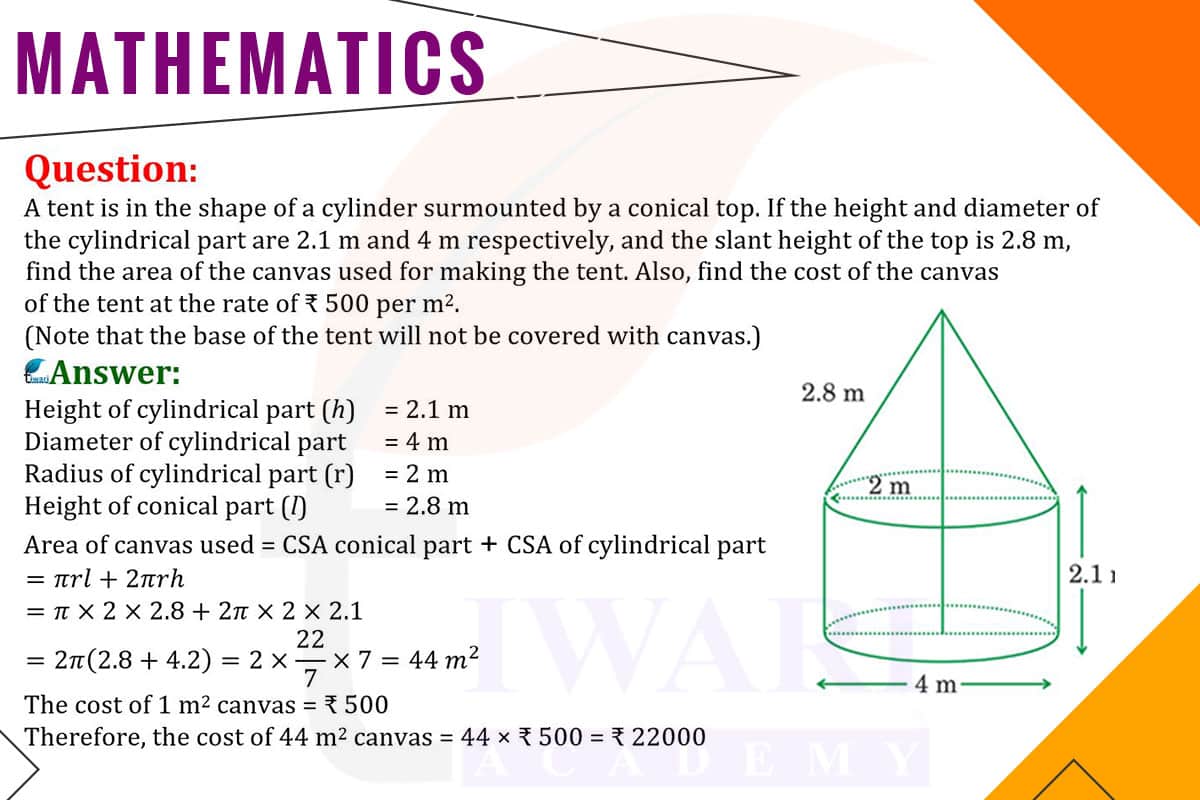To find the area of the canvas used for making a tent shaped like a cylinder surmounted by a conical top, we calculate the surface areas of both the cylindrical and conical parts separately.
For the cylinder, the height is 2.1 m and the diameter is 4 m, giving a radius of 2 m. The surface area of the cylindrical part (excluding the base) is 2πrh = 2π × 2 × 2.1.
For the conical part, the slant height is 2.8 m and the radius (same as the cylinder’s) is 2 m. The surface area of the cone is πrl = π × 2 × 2.8.
Adding these areas gives the total canvas area. The cost is calculated by multiplying this area by the rate of ₹500 per m². This calculation provides the total cost of the canvas needed to make the tent.

Let’s discuss in detail
Geometric Application in Practical Design
The design of a tent, which combines a cylindrical base with a conical top, presents a practical application of geometry. This problem involves calculating the area of the canvas needed to construct such a tent, a task that requires an understanding of the surface areas of both cylindrical and conical shapes. The challenge is not only to determine the amount of material required but also to calculate the cost of this material, providing insights into the practical aspects of geometric design in everyday objects. This exercise is a perfect example of how geometry is not just a theoretical subject but has real-world applications in various fields, including manufacturing and design.
Analyzing the Cylindrical Part of the Tent
The first step in our calculation is to analyze the cylindrical part of the tent. Given the height of 2.1 meters and a diameter of 4 meters, we can determine the radius as half the diameter, which is 2 meters. The surface area of the cylindrical part is calculated using the formula 2πrh, where r is the radius and h is the height. This formula calculates the lateral surface area of the cylinder, which is the part of the canvas that will wrap around the sides of the cylindrical base of the tent.
Calculating the Surface Area of the Conical Top
Next, we focus on the conical top of the tent. The slant height of the cone is given as 2.8 meters, and the radius is the same as that of the cylinder, 2 meters. The surface area of the cone is calculated using the formula πrl, where r is the radius and l is the slant height. This calculation gives us the area of the canvas required to cover the conical top of the tent. It’s important to note that this area represents the outer surface of the cone, which forms the top of the tent.
Total Surface Area of the Canvas
To find the total surface area of the canvas required for the tent, we add the surface areas of the cylindrical and conical parts. This involves summing the lateral surface area of the cylinder and the surface area of the cone. The total surface area represents the entire amount of canvas needed to construct the tent, excluding its base, as the base is typically left open.
Calculating the Cost of the Canvas
After determining the total surface area of the canvas, the next step is to calculate the cost. The cost is computed by multiplying the total surface area by the rate of ₹500 per square meter. This calculation provides the total cost of the canvas needed to make the tent, offering a practical insight into the expenses involved in manufacturing a tent of this design. It’s a crucial step for budgeting and resource allocation in the production process.
Bridging Geometry and Practicality
In conclusion, the process of calculating the surface area and cost of the canvas for a tent is a clear demonstration of the practical application of geometric principles. This exercise not only reinforces our understanding of the surface areas of cylinders and cones but also highlights the importance of geometry in practical design and manufacturing. It showcases how theoretical geometric concepts are applied in real-world scenarios, emphasizing the role of mathematics in everyday life. This problem-solving approach is not just about numbers and formulas; it’s about understanding how geometry can be used to create functional and efficient designs.
Discuss this question in detail or visit to Class 10 Maths Chapter 12 for all questions.
Questions of 10th Maths Exercise 12.1 in Detail


